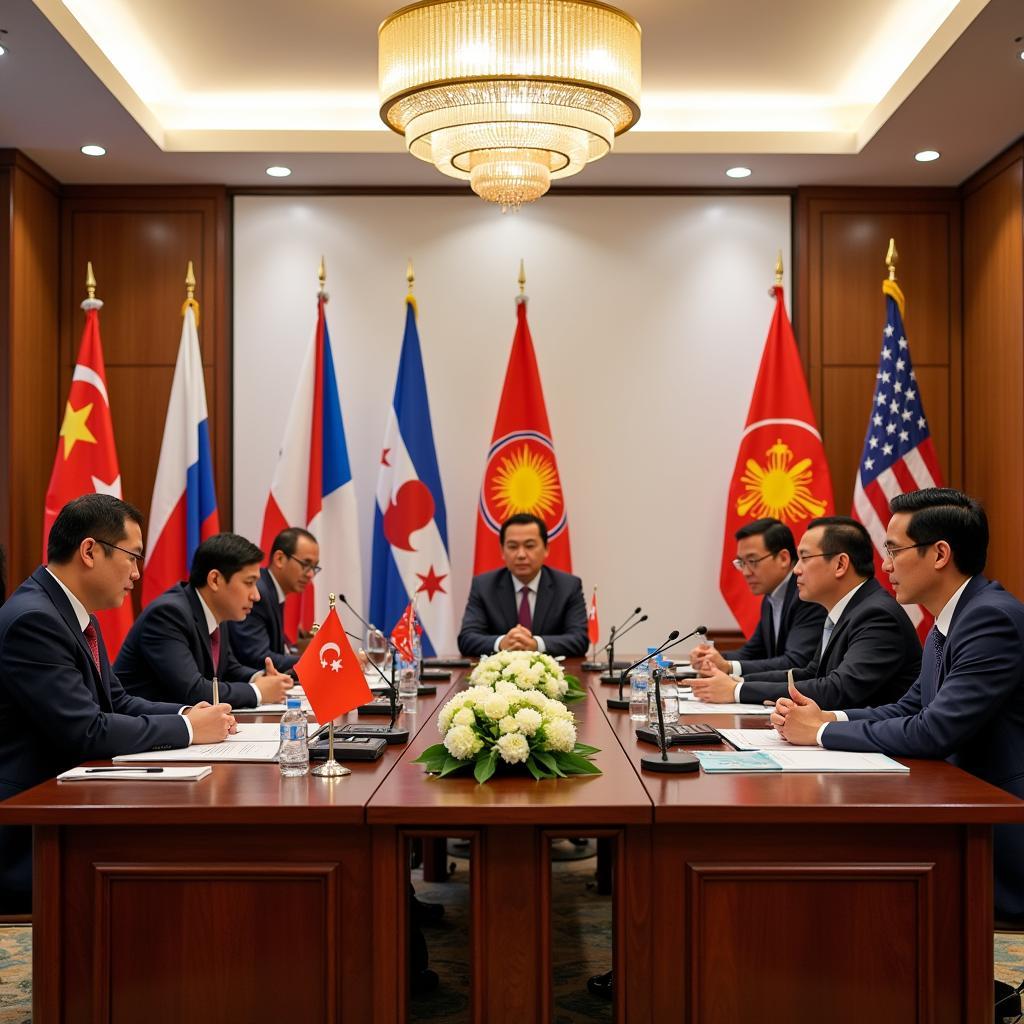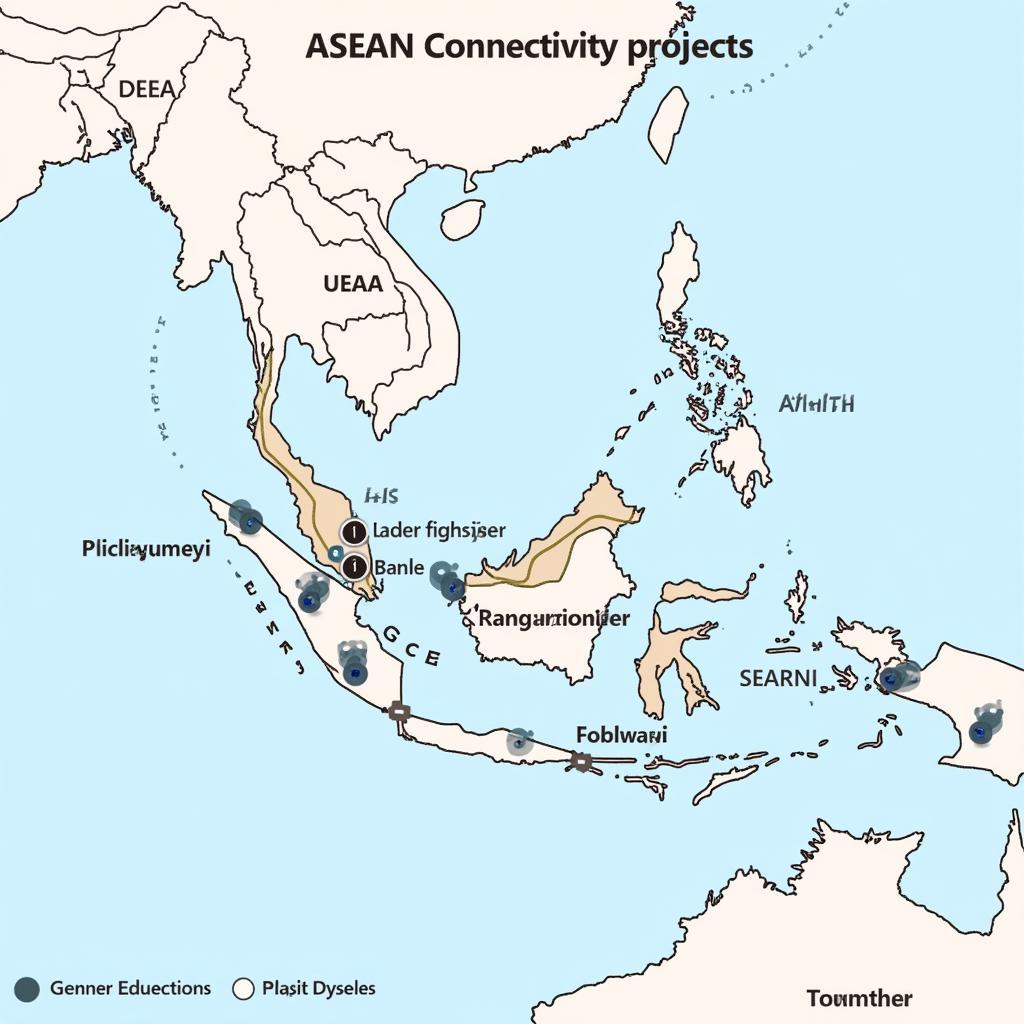The Association of Southeast Asian Nations (ASEAN) is a regional intergovernmental organization that promotes economic, political, security, and socio-cultural cooperation among its ten member states. Established in 1967, ASEAN’s foundation rests upon what is commonly referred to as the “4 Pillars Of Asean,” a framework designed to guide its multifaceted approach to regional integration.
Delving into the Core: What are the 4 Pillars of ASEAN?
The 4 pillars of ASEAN represent the key areas of cooperation that underpin the organization’s vision for a peaceful, stable, and prosperous Southeast Asia. These pillars are:
-
Political-Security Community: This pillar focuses on promoting peace, stability, and good governance within the region. It encompasses various initiatives aimed at conflict prevention, counter-terrorism, maritime security, and the promotion of human rights and democracy.
 ASEAN Security Summit
ASEAN Security Summit -
Economic Community: This pillar seeks to establish ASEAN as a single market and production base characterized by free flow of goods, services, investment, and skilled labor. It also emphasizes on strengthening regional economic competitiveness, promoting innovation, and narrowing the development gap among member states.
-
Socio-Cultural Community: Recognizing the importance of shared values and identity, this pillar focuses on fostering a sense of community within ASEAN by promoting cultural exchange, educational collaboration, and social development. It encompasses initiatives aimed at preserving cultural heritage, empowering youth, and addressing social issues such as poverty and inequality.
-
ASEAN Connectivity: While not explicitly included in the 2 asean definition, ASEAN Connectivity has emerged as a crucial aspect of the organization’s agenda. This pillar aims to enhance physical, institutional, and people-to-people connectivity within the region through improved infrastructure, streamlined regulations, and greater digital integration.
 ASEAN Connectivity Projects
ASEAN Connectivity Projects
Why are the 4 Pillars of ASEAN Important?
The 4 pillars of ASEAN are crucial for several reasons:
- Promoting Peace and Stability: By fostering dialogue, cooperation, and confidence-building measures, the political-security pillar aims to prevent conflicts and maintain stability in the region.
- Driving Economic Growth: The economic pillar seeks to create a more integrated and competitive ASEAN economy, attracting foreign investment and creating job opportunities for its citizens.
- Addressing Social Challenges: The socio-cultural pillar addresses critical social issues such as poverty, inequality, and environmental degradation, contributing to a more equitable and sustainable development path for the region.
- Enhancing Regional Integration: By promoting connectivity, ASEAN aims to break down barriers, facilitate trade and investment, and foster closer ties among its people.
The 4 Pillars in Action: Real-World Examples
The impact of the 4 pillars can be observed in numerous real-world examples:
- ASEAN Free Trade Area (AFTA): Established under the economic pillar, AFTA has significantly reduced tariffs among member states, boosting intra-ASEAN trade and investment.
- ASEAN Regional Forum (ARF): As a key platform for security dialogue under the political-security pillar, ARF brings together major powers to discuss regional security issues and build confidence.
- ASEAN Socio-Cultural Community Blueprint 2025: This blueprint, developed under the socio-cultural pillar, outlines a comprehensive plan to address social and cultural challenges facing the region.
- Master Plan on ASEAN Connectivity 2025 (MPAC 2025): This plan sets out strategic directions for enhancing physical, institutional, and people-to-people connectivity within ASEAN.
The Future of the 4 Pillars: Challenges and Opportunities
While the 4 pillars have provided a solid framework for ASEAN’s progress, the organization faces ongoing challenges and emerging opportunities:
- Narrowing the Development Gap: ASEAN must address economic disparities among member states and ensure that the benefits of integration reach all segments of society.
- Responding to Geopolitical Shifts: The evolving geopolitical landscape, marked by great power competition, requires ASEAN to navigate complex challenges to maintain its unity and centrality.
- Harnessing Digitalization: ASEAN needs to fully leverage the potential of digitalization to drive economic growth, improve governance, and connect its people.
“As ASEAN continues to evolve, strengthening the 4 pillars remains crucial. By addressing emerging challenges and seizing new opportunities, ASEAN can build on its past successes to achieve its vision of a resilient, dynamic, and people-centered community.” – Dr. Lina Nguyen, Director of the Center for ASEAN Studies
Conclusion
The 4 pillars of asean represent the cornerstone of the organization’s efforts to build a peaceful, prosperous, and integrated Southeast Asia. By fostering cooperation, addressing challenges, and adapting to a changing world, ASEAN can leverage the strength of its pillars to create a brighter future for its people and the region.
For further exploration on ASEAN topics, consider reading:
Need support? Contact us at Phone Number: 0369020373, Email: [email protected] or visit us at: Thon Ngoc Lien, Hiep Hoa, Bac Giang, Vietnam. We have a 24/7 customer support team ready to assist.

